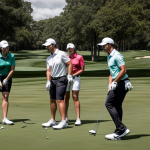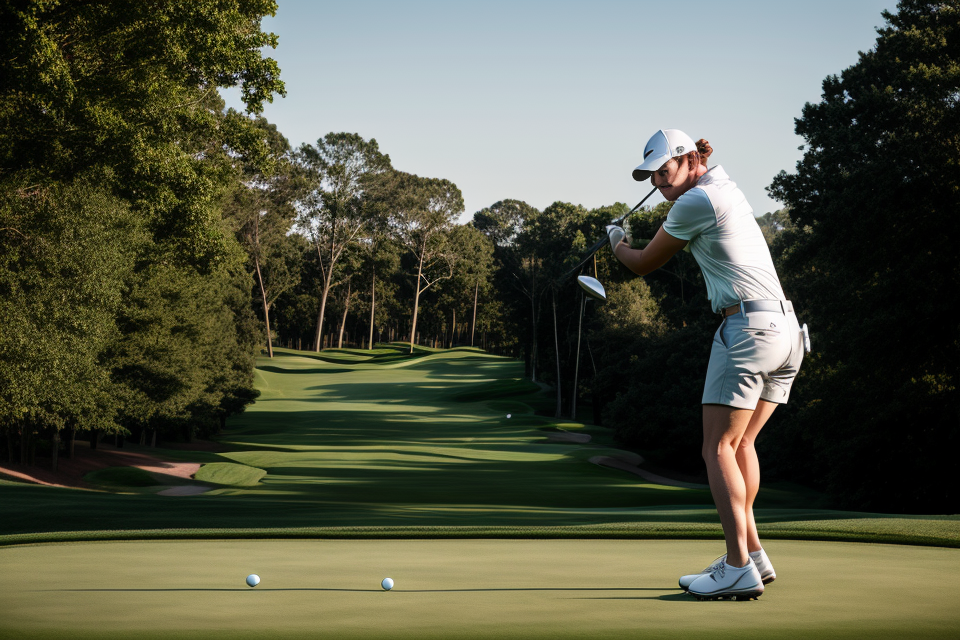Golf is a game that requires precision, control, and finesse. Mastering the golf swing is crucial to achieving success on the course. But how do you know which way you swing in golf? In this article, we will explore the fundamentals and key techniques of the golf swing, providing you with a comprehensive understanding of how to correctly execute each shot. From the setup to the follow-through, we will cover everything you need to know to master the golf swing and improve your game. So, get ready to take your golf game to the next level and learn how to swing with confidence and accuracy.
The Mental Aspect of Golf Swing
Focus and Visualization
Golf is a mental game, and the mental aspect of the swing is crucial to success on the course. One of the key mental skills that golfers need to master is focus and visualization. In this section, we will explore the importance of focus and visualization in the golf swing and provide tips for improving these skills.
Focus
Focus is the ability to concentrate on the task at hand and tune out distractions. In golf, focus is essential for executing a consistent and accurate swing. To improve focus, golfers should try the following:
- Practice mindfulness: Mindfulness is the practice of being present in the moment and focusing on the task at hand. Golfers can practice mindfulness by paying attention to their breath, the sensations in their body, and their thoughts and emotions.
- Eliminate distractions: Distractions can come in many forms, such as noise, other players, or thoughts about work or personal issues. Golfers should try to eliminate distractions by finding a quiet spot to practice, using noise-cancelling headphones, or taking a few deep breaths to calm their mind.
- Use visualization: Visualization is the ability to create mental images of a desired outcome. Golfers can use visualization to improve their focus by imagining the perfect shot before taking it.
Visualization
Visualization is the ability to create mental images of a desired outcome. In golf, visualization can help golfers execute a consistent and accurate swing. To improve visualization, golfers should try the following:
- Close their eyes: Golfers can use their imagination to create mental images of a desired outcome by closing their eyes and focusing on the sensations of a successful shot.
- Use mental rehearsal: Mental rehearsal is the process of imagining a desired outcome in detail. Golfers can use mental rehearsal to improve their visualization skills by imagining a successful shot in detail, including the feel of the club in their hands, the sound of the ball hitting the fairway, and the sense of satisfaction that comes with a good shot.
- Use positive self-talk: Positive self-talk is the process of using positive affirmations to boost confidence and motivation. Golfers can use positive self-talk to improve their visualization skills by telling themselves that they can execute a successful shot.
By improving their focus and visualization skills, golfers can improve their mental game and achieve success on the course.
Managing Pressure and Nerves
When it comes to mastering the golf swing, it’s not just about physical techniques and mechanics. The mental aspect of the game is just as important, and managing pressure and nerves is a crucial part of this. Here are some tips to help you stay calm and focused on the course:
- Preparation: One of the best ways to manage pressure and nerves is to prepare as much as possible. This means not only practicing your swing, but also practicing your mental game. Take time to visualize yourself making successful shots, and practice focusing on the present moment rather than dwelling on past mistakes or worrying about future outcomes.
- Breathing: Another important aspect of managing pressure and nerves is your breathing. When we get anxious or stressed, our breathing often becomes shallow and rapid. Practice taking deep, slow breaths to help calm your body and mind. You can also try taking a few deep breaths before you swing, to help you focus and relax.
- Positive Self-Talk: Our inner dialogue can have a powerful impact on our emotions and behaviors. Try to cultivate a positive inner dialogue by focusing on your strengths and accomplishments, rather than dwelling on your weaknesses or mistakes. Speak to yourself in a kind and supportive manner, and remind yourself of all the hard work and practice you’ve put in.
- Trust Your Abilities: It’s important to trust in your abilities and have confidence in your swing. Trust that you’ve practiced enough and that you know how to make a good shot. Remember that even the best golfers miss shots sometimes, and it’s all part of the game. Trust yourself and your swing, and don’t let self-doubt or fear hold you back.
- Stay in the Present Moment: Finally, it’s important to stay focused on the present moment, rather than getting caught up in worrying about the future or dwelling on past mistakes. Take each shot one at a time, and try to enjoy the process of playing the game. Remember that golf is a game, and it’s supposed to be fun. So don’t put too much pressure on yourself, and try to enjoy the journey of mastering your swing.
The Grip
The Correct Grip Pressure
The grip is a crucial aspect of the golf swing, and one of the most important elements of the grip is the correct grip pressure. Many golfers tend to grip the club too tightly, which can lead to tension in the hands and arms, and a loss of power and control in the swing. On the other hand, a grip that is too loose can cause the club to twist and move during the swing, leading to inaccurate shots.
To find the correct grip pressure, it is important to hold the club in a relaxed manner, with the fingers wrapped around the grip and the palms facing each other. The grip should be firm, but not to the point of causing discomfort or tension. One way to test the grip pressure is to close the eyes and take a practice swing, then ask a partner or coach to observe if the club moves excessively during the swing.
Another tip for finding the correct grip pressure is to practice holding the club in a relaxed manner for an extended period of time, such as while waiting to tee off. This can help to build the muscle memory needed to maintain a consistent grip pressure throughout the swing.
In addition to the correct grip pressure, it is also important to maintain a neutral grip, with the palms facing each other and the fingers pointing down towards the ground. This grip allows for a natural and efficient transfer of power from the body to the club, and helps to prevent excessive twisting and movement of the club during the swing.
Overall, finding the correct grip pressure is essential for mastering the golf swing, and can make a significant difference in the accuracy and power of shots. By holding the club in a relaxed and neutral manner, golfers can build the muscle memory needed to maintain a consistent grip pressure throughout the swing, leading to improved performance on the course.
The Grip for Different Shots
The grip is one of the most critical aspects of the golf swing, as it lays the foundation for all the movements that follow. While there are some commonalities in the grip for different shots, there are also key differences that can have a significant impact on the outcome of the shot. In this section, we will explore the grip for different shots, including the full swing, chip shots, and putting.
Full Swing Grip
In the full swing, the grip is typically more neutral, with the hands slightly ahead of the club’s shaft. This allows for a more powerful and controlled swing, as the hands can move independently of the clubhead through impact. To achieve a neutral grip, place the hands on the club in a natural position, with the palms facing each other and the thumbs slightly outward. The fingers should be intertwined, with the index finger resting on top of the handle.
Chip Shot Grip
In chip shots, the grip is often more abbreviated, with the hands closer to the club’s head. This is because the goal is to make a controlled, short swing that generates spin and lift, rather than distance. To achieve a proper chip shot grip, place the hands slightly closer together than in a full swing grip, with the clubface resting on the ground just behind the ball. The grip should be light and relaxed, with the wrists bent slightly.
Putting Grip
In putting, the grip is the most relaxed of all, with the hands barely holding the club at all. The goal is to use the hands to guide the clubhead, rather than to power it. To achieve a proper putting grip, place the hands on the club in a neutral position, with the thumbs slightly outward and the fingers intertwined. The grip should be light and relaxed, with the wrists barely bent.
In conclusion, the grip is a critical aspect of the golf swing, and the grip for different shots can vary significantly. Whether it’s a full swing, chip shot, or putting, the grip should be tailored to the specific shot and the golfer’s personal style. By mastering the grip for different shots, golfers can improve their accuracy, distance, and overall performance on the course.
The Stance
The Proper Stance for Different Shots
The proper stance is a crucial aspect of mastering the golf swing. It is important to note that the stance for different shots can vary, and it is essential to understand how to adjust the stance for each shot to ensure maximum power and accuracy.
When taking a driver shot, the stance should be slightly open, with the feet about shoulder-width apart. The weight should be distributed evenly on both feet, with the lead foot slightly forward. The knees should be slightly bent, and the hips should be rotated slightly away from the target. The arms should be relaxed, with the club resting on the ground in front of the body.
For a short iron shot, the stance should be slightly closed, with the feet together. The weight should be distributed evenly on both feet, with the lead foot slightly back. The knees should be slightly bent, and the hips should be rotated slightly towards the target. The arms should be relaxed, with the club resting on the ground in front of the body.
When taking a chip shot, the stance should be even more closed, with the feet almost touching. The weight should be distributed on the lead foot, with the trail foot slightly back. The knees should be slightly bent, and the hips should be rotated towards the target. The arms should be relaxed, with the club resting on the ground in front of the body.
In summary, the proper stance for different shots is essential to mastering the golf swing. The stance should be adjusted for each shot to ensure maximum power and accuracy. The key to finding the right stance is to practice and experiment with different stances until you find the one that works best for you.
The Importance of Balance and Alignment
Balance in Golf Swing
In golf, balance is crucial as it helps to maintain control and stability throughout the swing. A balanced stance ensures that the weight is distributed evenly on both feet, allowing for smooth movements and preventing loss of balance. The knees should be slightly bent, and the spine should remain straight to maintain a strong foundation.
Alignment in Golf Swing
Alignment is another essential aspect of the golf swing, as it affects the accuracy and direction of the shot. Proper alignment involves lining up the body, feet, and shoulders in a straight line towards the target. This helps to ensure that the club is swung along the correct path, leading to a more accurate shot.
Importance of Balance and Alignment in Golf Swing
Balance and alignment are closely related, as they both contribute to the overall stability and control of the swing. A balanced stance allows for smooth movements and a consistent swing, while proper alignment ensures that the shot is directed towards the intended target. Mastering these fundamentals is essential for developing a powerful and accurate golf swing.
The Swing
The Kinetic Chain Reaction
The kinetic chain reaction is a crucial concept in understanding the golf swing. It refers to the sequential movement of the body’s joints and muscles during the swing, creating a smooth and efficient motion. The kinetic chain reaction begins with the upper body, then moves down to the lower body, and finally concludes with the arms and club.
Here are the key components of the kinetic chain reaction:
- Upper Body
- Shoulders
- Hips
- Torso
- Lower Body
- Knees
- Ankles
- Arms and Club
- Wrists
- Forearms
Each component of the kinetic chain reaction works together to create a powerful and accurate golf swing. The upper body sets the foundation for the swing, with the hips initiating the movement and the torso rotating to generate power. The lower body then kicks in, with the knees and ankles providing stability and support. Finally, the arms and club complete the swing, with the wrists and forearms controlling the direction and power of the shot.
It is important to note that the kinetic chain reaction should be smooth and continuous, without any jerky or abrupt movements. Any disruption in the chain can lead to a loss of power and accuracy. Therefore, golfers must focus on maintaining a consistent rhythm and tempo throughout the swing, ensuring that each component of the kinetic chain reaction works in harmony.
In summary, the kinetic chain reaction is a critical aspect of mastering the golf swing. By understanding the sequential movement of the body’s joints and muscles, golfers can develop a smoother and more efficient swing, resulting in more accurate and powerful shots.
The Transition from Top of the Swing to Impact
At the top of the swing, the golfer’s hands, arms, and club are parallel to the ground, and the golfer’s weight is evenly distributed on both feet. The key to a successful transition from the top of the swing to impact is to maintain this position and keep the club on plane throughout the downswing.
To achieve this, the golfer should focus on a few key techniques:
- Keep the hands and arms relaxed and allow the club to drop naturally.
- Use the legs and core to initiate the downswing, rather than the arms and hands.
- Maintain the angle of attack, which is the angle between the club and the ground, and keep it consistent throughout the swing.
- Allow the club to rotate in the hands during the downswing, which helps to square the clubface to the target.
- Keep the weight on the front foot until impact, then transfer the weight to the back foot and finish in a balanced position.
By mastering these techniques, golfers can improve their consistency and accuracy, and reduce the risk of injury. It’s important to practice these techniques in a controlled environment, such as a driving range or practice area, before incorporating them into actual play.
The Follow-Through
Maintaining the Spine Angle
The spine angle during the follow-through is a crucial aspect of maintaining a proper golf swing. This angle, which is formed between the upper and lower back, plays a significant role in generating power and control through impact.
Maintaining the spine angle begins with the transition from the backswing to the downswing. As the club moves from the inside to the outside of the target line, the golfer should rotate the hips and torso to maintain the angle formed by the spine. This rotation helps to create a stable, powerful swing and prevent any loss of power or control.
To effectively maintain the spine angle, it is important to keep the lower body stable and engaged throughout the swing. This includes maintaining a strong connection between the hips and the shoulders, as well as keeping the feet planted firmly on the ground. This stability helps to transfer power from the lower body to the upper body, allowing for a smooth, efficient swing.
Additionally, it is important to avoid any lateral movement of the spine during the swing. This can lead to a loss of power and control, as well as an increased risk of injury. To prevent lateral movement, golfers should focus on maintaining a steady, stable spine angle throughout the swing.
Overall, maintaining the spine angle during the follow-through is a critical aspect of a proper golf swing. By rotating the hips and torso, keeping the lower body stable, and avoiding lateral movement, golfers can generate power and control through impact and maintain a smooth, efficient swing.
Finishing the Swing with Power and Control
To complete a successful golf swing, it is essential to have a proper follow-through. This phase of the swing involves maintaining control and power, ensuring that the ball is sent on its intended path. The follow-through is not merely an afterthought; it is a critical component of the golf swing that should be practiced and perfected.
A proper follow-through starts with keeping the left arm straight and extended, which allows for a smooth transition into the finish. The right arm should also be extended, with the club pointing towards the target. The body should remain in balance, with the weight shifted towards the left foot. This balance is crucial, as it ensures that the swing is completed with power and control.
The follow-through is also an opportunity to evaluate the swing’s quality. A good finish is characterized by a smooth, fluid motion that ends with the club and body in a balanced position. If the finish is abrupt or jerky, it may indicate an issue with the swing’s timing or balance.
One of the key techniques to mastering the follow-through is the use of the trailing arm. As the club reaches the top of the backswing, the trailing arm should be relaxed and extended, creating a straight line from the shoulder to the wrist. This technique allows for a smooth transition into the finish and promotes power and control.
Another important aspect of the follow-through is the wrist hinge. The wrists should remain hinged during the swing, creating a strong, stable platform for the club to strike the ball. As the club moves towards the target, the wrists should begin to unhinge, releasing power and control into the shot.
Finally, the finish of the swing is a good time to evaluate the body’s positioning. The shoulders, hips, and feet should all be aligned towards the target, creating a strong, stable base for the swing. This alignment is crucial for achieving power and control in the swing.
In conclusion, the follow-through is a critical component of the golf swing that should be practiced and perfected. By maintaining control and power, using the trailing arm and wrist hinge, and ensuring proper alignment, golfers can achieve a successful finish to their swing and send the ball on its intended path.
Tips for Improving Your Golf Swing
Practicing with Purpose
Practicing with purpose is a crucial aspect of improving your golf swing. To become a proficient golfer, it is essential to engage in targeted and focused practice sessions that help you develop and master the key techniques of the golf swing. Here are some tips for practicing with purpose:
- Identify your weaknesses: Start by identifying the areas of your swing that need improvement. This can be done by recording your swings using a camera or by seeking feedback from a golf instructor. Once you have identified your weaknesses, focus your practice sessions on addressing these specific issues.
- Set goals: Set specific and measurable goals for your practice sessions. For example, if you want to improve your driving distance, set a goal to hit a certain number of balls with the driver each practice session. This will help you stay focused and motivated during your practice sessions.
- Use video analysis: Video analysis is a valuable tool for improving your golf swing. Record your swings using a camera and review the footage to identify any technical flaws or areas for improvement. You can then use this information to adjust your swing and focus your practice sessions on the areas that need the most work.
- Focus on the basics: It is important to remember that the golf swing is a complex motion that involves many different elements. Focusing on the basics, such as grip, stance, and alignment, will help you build a solid foundation for your swing. Spend time practicing these fundamental elements to ensure that you have a solid base to build upon.
- Incorporate drills: Drills are a great way to practice specific aspects of the golf swing. Incorporate drills into your practice sessions that focus on areas such as balance, tempo, and swing plane. This will help you develop a more consistent and repeatable swing.
- Practice under pressure: Golf is a mental game, and practicing under pressure can help you develop the mental toughness needed to perform well on the course. Set up practice scenarios that simulate real-game situations, such as hitting shots under time pressure or from difficult lies. This will help you develop the ability to perform under pressure.
By practicing with purpose, you can make the most of your practice time and make significant improvements to your golf swing.
Using Video Analysis for Feedback
Video analysis is a powerful tool that can help golfers improve their swing by providing visual feedback on their movements. Here are some tips for using video analysis to improve your golf swing:
- Record your swing: Start by recording your swing using a camera or smartphone. Make sure to capture your swing from multiple angles, including from the side, down the line, and from behind.
- Analyze your swing: Once you have recorded your swing, it’s time to analyze the footage. Look for key areas of your swing, such as your backswing, downswing, and impact. Pay attention to your body position, rotation, and movements throughout the swing.
- Identify problem areas: Use the video analysis to identify any problem areas in your swing. Look for things like poor alignment, a weak grip, or a casting motion. These are common issues that can cause a golfer’s swing to break down.
- Practice correcting issues: Once you have identified problem areas in your swing, it’s time to practice correcting them. Take the time to practice the correct movements and techniques, whether it’s improving your grip, increasing your clubhead speed, or working on your body position.
- Compare progress: Keep track of your progress over time by re-recording your swing and comparing the footage. This will help you see how far you’ve come and what areas you still need to work on.
By using video analysis for feedback, golfers can gain a better understanding of their swing and identify areas for improvement. This tool can be especially helpful for those who are new to the game or for those who are struggling with specific aspects of their swing.
Incorporating Strength Training and Flexibility Exercises
One of the most important aspects of mastering the golf swing is ensuring that your body is in peak physical condition. While some may believe that golf is a game that only requires minimal physical exertion, the truth is that even the slightest movements and adjustments can have a significant impact on your shot. By incorporating strength training and flexibility exercises into your regular routine, you can improve your overall physical fitness and reduce the risk of injury.
Strength Training
Strength training is an essential component of any athletic activity, and golf is no exception. By incorporating strength exercises into your routine, you can improve your overall muscle strength and endurance, which can help you generate more power and control in your swings. Some of the best strength exercises for golfers include:
- Deadlifts: This exercise targets the hamstrings, glutes, and lower back muscles, which are all critical for maintaining proper posture and balance during your swing.
- Squats: Squats are another excellent exercise for improving lower body strength and endurance. They can help you develop the muscles needed to maintain proper balance and control throughout your swing.
- Shoulder presses: Shoulder presses are great for strengthening the muscles in your shoulders, which are essential for maintaining proper swing mechanics.
Flexibility Exercises
In addition to strength training, it’s also important to incorporate flexibility exercises into your routine. These exercises can help improve your range of motion and reduce the risk of injury. Some of the best flexibility exercises for golfers include:
- Hamstring stretches: Hamstring stretches can help improve flexibility in the back of your legs, which can help you maintain proper posture and balance during your swing.
- Calf stretches: Calf stretches can help improve flexibility in your lower legs, which can help you maintain proper balance and control throughout your swing.
- Hip stretches: Hip stretches can help improve flexibility in your hips, which are critical for maintaining proper swing mechanics.
Incorporating Strength and Flexibility Exercises into Your Routine
To get the most out of your strength and flexibility exercises, it’s important to incorporate them into your regular routine. Consider setting aside time each day to perform these exercises, and be sure to warm up before starting any strenuous activity. Additionally, be sure to listen to your body and take breaks as needed to avoid injury.
By incorporating strength and flexibility exercises into your routine, you can improve your overall physical fitness and reduce the risk of injury. This can help you perform at your best on the golf course, allowing you to hit longer, straighter shots and enjoy the game to the fullest.
Recap of Key Points
To recap, mastering the golf swing requires understanding the fundamentals and key techniques. This involves:
- Correct grip and stance: A neutral grip with the palms facing the target, and a shoulder-width stance with the weight distributed evenly on both feet.
- Proper posture and alignment: A tall, upright posture with the shoulders aligned with the hips, and the feet and hips pointing towards the target.
- Balanced body movement: A smooth, rhythmic motion with the upper and lower body working in unison, and the head and eyes focused on the target.
- Efficient use of the arms and hands: A smooth, controlled swing with the arms and hands working in conjunction with the body, and the wrists and elbows locked at the top of the swing.
- Powerful core and leg engagement: The core and legs working together to generate power and stability throughout the swing, with the legs pushing off the ground to generate speed and distance.
- Proper impact and follow-through: The clubhead striking the ball squarely and directly, with the hands and arms continuing through impact and following through to the finish.
By incorporating these key points into your golf swing, you can improve your accuracy, distance, and overall performance on the course. Remember to practice regularly, focus on your form, and seek feedback from a qualified instructor if necessary. With time and dedication, you can master the golf swing and achieve your desired results.
The Importance of Patience and Persistence
One of the most crucial aspects of mastering the golf swing is to develop patience and persistence. Many golfers get frustrated when they don’t see immediate results or make mistakes, which can lead to poor form and incorrect techniques. It’s important to understand that golf is a game of precision and accuracy, and it takes time and practice to develop the necessary skills.
Developing patience is essential in golf because it allows you to take your time and make accurate swings. Rushing through your swing can lead to mistakes and poor form, which can result in lost shots and increased frustration. It’s important to take your time and focus on each shot, using proper techniques and paying attention to detail.
Persistence is also key to mastering the golf swing. Golf is a challenging sport, and it’s natural to make mistakes and encounter obstacles along the way. However, it’s important to keep practicing and persevering, even when things get tough. With persistence, you’ll be able to develop the necessary skills and improve your golf swing over time.
Another important aspect of patience and persistence is to stay focused on your goals. It’s easy to get distracted by external factors, such as the weather or other players, but it’s important to stay focused on your own game. By setting clear goals and staying focused on them, you’ll be able to make steady progress and improve your golf swing over time.
In conclusion, patience and persistence are essential when it comes to mastering the golf swing. By developing these qualities, you’ll be able to stay focused on your goals, take your time, and make steady progress. Remember, golf is a game of precision and accuracy, and it takes time and practice to develop the necessary skills. So, be patient, stay persistent, and keep practicing!
Continuing to Refine Your Swing for Optimal Performance
Refining your golf swing is an ongoing process that requires dedication and patience. To continue improving your swing, consider the following tips:
- Analyze your swing: Use slow-motion video analysis or a swing simulator to identify areas for improvement. Look for things like poor alignment, inconsistent body rotation, or an uneven swing plane.
- Practice regularly: Consistent practice is key to making lasting improvements to your swing. Set aside time each week to practice your swing, focusing on specific areas that need improvement.
- Work on your weaknesses: Identify the areas of your swing that need the most work and focus on improving them. For example, if you struggle with hitting the ball straight, spend more time practicing your aim and ball positioning.
- Get professional help: If you’re stuck and can’t seem to make progress on your own, consider working with a golf instructor. A professional can provide personalized feedback and help you develop a plan for improvement.
- Stay focused: Golf can be a frustrating game, but it’s important to stay focused on your goals. Remember why you started playing golf and what you hope to achieve, and use that motivation to drive you forward.
FAQs
1. How do you know which way you swing in golf?
One of the most important aspects of golf is having a proper swing. However, it can be difficult to know which way you should be swinging the club. To determine the correct swing direction, you need to stand behind the ball and align your body with the target. Look at the direction you want the ball to go and make sure your feet, knees, hips, and shoulders are all aligned in that direction. If you are right-handed, your left shoulder should be aimed at the target. If you are left-handed, your right shoulder should be aimed at the target. Additionally, you can also use the position of the sun, the wind direction, and the shape of the golf course to help you determine the correct swing direction.
2. What are the key techniques for a good golf swing?
A good golf swing involves several key techniques that can take time to master. One of the most important is the grip, which should be firm but relaxed. The hands should be placed on the club in a neutral position, with the palms facing each other. The stance should be athletic, with the feet shoulder-width apart and the knees slightly bent. The shoulders should be relaxed and level, with the head facing the target. The swing itself should be smooth and rhythmic, with the arms and legs working together to bring the clubhead back to the ball and then through it. It’s also important to maintain a smooth and balanced finish, with the clubhead coming to a complete stop after impact.
3. How can I improve my golf swing?
Improving your golf swing takes practice and patience. The first step is to get a proper golf lesson from a qualified instructor, who can assess your swing and provide personalized feedback and advice. You can also practice swinging in front of a mirror or using video analysis to get a better understanding of your technique. It’s important to practice regularly, both on the driving range and on the golf course, and to focus on making small, incremental improvements rather than trying to change everything at once. Finally, it’s important to stay relaxed and focused, and to trust your instincts and body movements. With time and effort, you can develop a smooth and powerful golf swing that will help you shoot lower scores.





